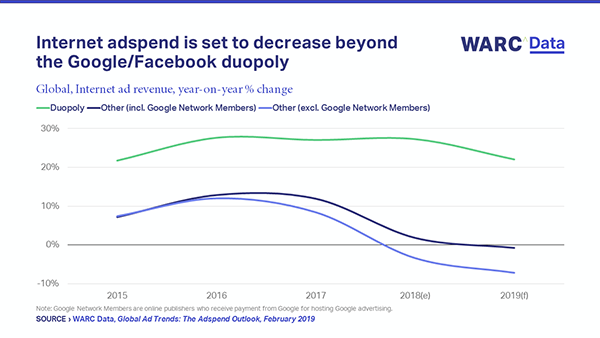This is according to WARC’s Global Advertising Trends report, out today. Compared to 2018’s 5.4% rise – the strongest since 2011 – the forecast for this year is slightly softer. Nevertheless, top line growth is healthy, with advertising's share of global GDP holding at 0.7% over the last decade.
But James McDonald, Data Editor, WARC, who authored the research, noted the dramatic changes in the global ad market’s undercurrents.
“The amount of ad money available to online publishers beyond Google and Facebook is now in decline, and the repercussions are potentially far-reaching, with several high-profile announcements of job cuts seen among online publishers already this year.
“Print publishers have already been severely hit by the migration of ad dollars online, and while traditional media excluding print have fared admirably to date, their collective take of ad investment is also trending downwards.”
Under the Duopoly
Total internet advertising spend – including desktop, mobile, and tablet – will decline by 7.2% this year, if you take the Google and Facebook ‘duopoly’ out of the equation.
Even if Google's Traffic Acquisition Costs (TACs) – money paid to Google Network Members for hosting Google ads – are accounted for, internet spend beyond the duopoly is expected to dip by 0.7% in 2019.
Combined, the duopoly’s share of the global online ad market is expected to rise to 61.4% (up from 56.4% in 2018), with combined ad income forecast to reach $176.4 billion – an increase of 22%.

Looking at the total internet advertising market, spend is expected to rise 12.1% to $287.4bn worldwide this year. This would give internet a 46.7% share of media spend globally.
But in the US – the world’s largest ad market – internet is expected to account for over half (54.0%) of all media spend for the first time this year.
Mobile
Within internet, mobile adspend is expected to rise 21.9% to reach US$165.7bn in 2019, placing it as the second-largest ad channel worldwide across 96 markets.
However, across WARC’s 12 key markets – Australia, Brazil, Canada, China, France, Germany, India, Italy, Japan, Russia, UK, US – mobile is predicted to overtake TV to become the largest ad channel this year.
Most traditional channels expected to lose some market share
Out of home (OOH) continues to benefit from the integration of digital sites, especially in advanced markets. Digital out of home (DOOH) is expected to account for all of the 2.3% growth in OOH spend this year, as it already does in the UK. The medium's share is, however, expected to dip by 0.1pp in 2019.
Meanwhile, radio is forecast to grow 1% to $32.5 billion this year, following a 1.2% rise in 2018. But this equates to a 0.2pp loss of global share each year.
Cinema is expected to be the only ad channel other than mobile not to lose share of global advertising spend this year; spend here is expected to rise 7.7% to $4.7bn.
While TV will continue to be the largest single advertising medium in 2019, bringing in $195.5 billion dollars, this represents a 1.3% dip from 2018’s figures. On average, however, TV spend will have grown 0.4% each year since 2011.
Print is predicted to dip 6.9% in 2019, as legacy news publishers scramble to diversify their revenue sources to make up for a halving of ad revenue since 2009.
Regional data
- North America: Total market growth is forecast at 3.7% this year, following an estimated 6.0% rise in 2018 (buoyed by the US midterms and brand spend during the Winter Olympics).
- Asia-Pacific: Growth has been relatively strong since 2011, with an increasingly digital China accounting for near half of all adspend. A 5.8% rise predicted for the region this year.
- Western Europe: The region recorded the strongest growth in 2018, at 9.2%, though this is expected to ease to 3.5% in 2019.
- Central & Eastern Europe: The region is expected to record the strongest growth this year, at 10.6%, driven by a strengthening Russian market.
- Latin America: The region is heavily susceptible to the strength of the US dollar, which resulted in an 8.3% decline in adspend last year. A rise of 3.8% is forecast for 2019.
- Middle East: Markets in the region have been severely hit by the sharp falls in the price of oil, particularly in Saudi Arabia and the UAE. As such, the region has been in decline since 2015 and this trend will continue in 2019.
- Africa: Regional growth is largely dependent on South Africa (44.2% of the total), which entered a technical recession in 2018. A rise of 4.3% is forecast for Africa in 2019.
Sourced from WARC
